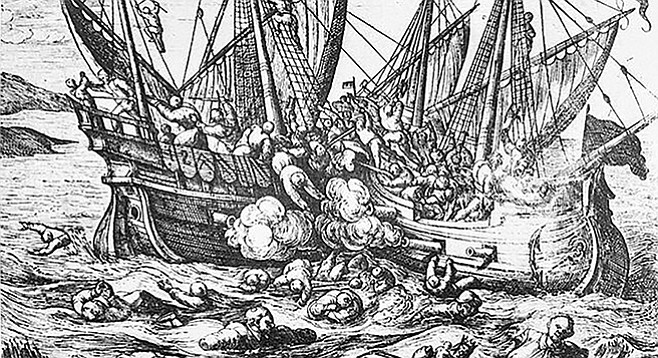 Facebook
Facebook
 X
X
 Instagram
Instagram
 TikTok
TikTok
 Youtube
Youtube

The first modern industrial activity in the Americas was shipbuilding in the early 17th century, some 60 years after Juan Rodríguez Cabrillo set foot on Point Loma. Among the ships used by explorers in the 16th Century were the Spanish galleons, which carried more sails than the earlier vessels and were commissioned in fleets of several ships. Galleon armaments toward the mid to late 16th Century were cannon, hand-thrown projectiles utilizing gunpowder, hot tar or lime (to blind their victims), muskets, swords, and crossbows. It was a galleon that brought Cabrillo to San Diego Bay on September 28, 1542.
Sailors aboard these ships lived in close quarters. For sleep, the two-thirds of the crew not on watch found spots wherever they could on the top deck and were rousted by the movement of men and sails while they slept. For food, sailors were provided, generally, three meals a day of stored goods such as rice, chick peas, and salt pork, and they harvested fish and sea turtles. Wine was provided daily if available, and, though the crew onboard often ate a better diet than the average laborer on land, violence usually followed extreme shortages of food and/or drink. Many of the crew died during voyages. Rigging systems were created to enable a small surviving crew to sail the ship home.
Visit Living History VIPs at the Cabrillo Monument, Saturdays, 1:30–2:30 p.m. through December 26.


The first modern industrial activity in the Americas was shipbuilding in the early 17th century, some 60 years after Juan Rodríguez Cabrillo set foot on Point Loma. Among the ships used by explorers in the 16th Century were the Spanish galleons, which carried more sails than the earlier vessels and were commissioned in fleets of several ships. Galleon armaments toward the mid to late 16th Century were cannon, hand-thrown projectiles utilizing gunpowder, hot tar or lime (to blind their victims), muskets, swords, and crossbows. It was a galleon that brought Cabrillo to San Diego Bay on September 28, 1542.
Sailors aboard these ships lived in close quarters. For sleep, the two-thirds of the crew not on watch found spots wherever they could on the top deck and were rousted by the movement of men and sails while they slept. For food, sailors were provided, generally, three meals a day of stored goods such as rice, chick peas, and salt pork, and they harvested fish and sea turtles. Wine was provided daily if available, and, though the crew onboard often ate a better diet than the average laborer on land, violence usually followed extreme shortages of food and/or drink. Many of the crew died during voyages. Rigging systems were created to enable a small surviving crew to sail the ship home.
Visit Living History VIPs at the Cabrillo Monument, Saturdays, 1:30–2:30 p.m. through December 26.
Comments